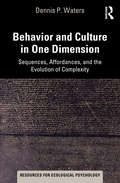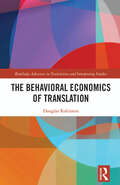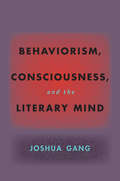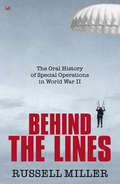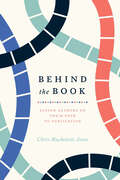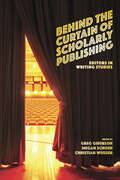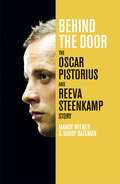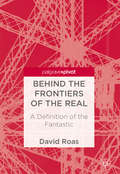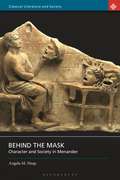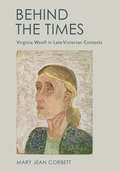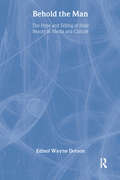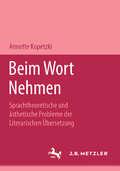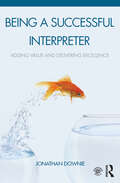- Table View
- List View
Behavior and Culture in One Dimension: Sequences, Affordances, and the Evolution of Complexity (Resources for Ecological Psychology Series)
by Dennis WatersBehavior and Culture in One Dimension adopts a broad interdisciplinary approach, presenting a unified theory of sequences and their functions and an overview of how they underpin the evolution of complexity.Sequences of DNA guide the functioning of the living world, sequences of speech and writing choreograph the intricacies of human culture, and sequences of code oversee the operation of our literate technological civilization. These linear patterns function under their own rules, which have never been fully explored. It is time for them to get their due. This book explores the one-dimensional sequences that orchestrate the structure and behavior of our three-dimensional habitat. Using Gibsonian concepts of perception, action, and affordances, as well as the works of Howard Pattee, the book examines the role of sequences in the human behavioral and cultural world of speech, writing, and mathematics. The book offers a Darwinian framework for understanding human cultural evolution and locates the two major informational transitions in the origins of life and civilization. It will be of interest to students and researchers in ecological psychology, linguistics, cognitive science, and the social and biological sciences.
The Behavioral Economics of Translation (Routledge Advances in Translation and Interpreting Studies)
by Douglas RobinsonThis book applies frameworks from behavioral economics to Western thinking about translation, mapping four approaches to eight keywords in translation studies to bring together divergent perspectives on the study of translation and interpreting. The volume takes its points of departure from the tensions between the concerns of behavioral and neoclassical economists. The book considers on one side behavioral economists’ interest in the predictable irrationality of “Humans” and its nuances as they unfold in terms of gender, here organized around Masculine Human, Feminine Human, and Queer perspectives, and on the other side neoclassical economists’ chief concerns with the unfailing rationality of the “Econs.” Robinson applies these four approaches across eight chapters, each representing a keyword in the study of translation—agency; difference; Eurocentrism; hermeneutics; language; norms; rhetoric; and world literature—with case studies that problematize the different categories. Taken together, the book offers a comprehensive treatment of the behavioral economics of translation and promotes new ways of thinking in the study of translation and interpreting, making it of interest to scholars in the discipline as well as those working along interdisciplinary lines in related fields such as philosophy, literature, and political science.
The Behavioral Economics of Translation (Routledge Advances in Translation and Interpreting Studies)
by Douglas RobinsonThis book applies frameworks from behavioral economics to Western thinking about translation, mapping four approaches to eight keywords in translation studies to bring together divergent perspectives on the study of translation and interpreting. The volume takes its points of departure from the tensions between the concerns of behavioral and neoclassical economists. The book considers on one side behavioral economists’ interest in the predictable irrationality of “Humans” and its nuances as they unfold in terms of gender, here organized around Masculine Human, Feminine Human, and Queer perspectives, and on the other side neoclassical economists’ chief concerns with the unfailing rationality of the “Econs.” Robinson applies these four approaches across eight chapters, each representing a keyword in the study of translation—agency; difference; Eurocentrism; hermeneutics; language; norms; rhetoric; and world literature—with case studies that problematize the different categories. Taken together, the book offers a comprehensive treatment of the behavioral economics of translation and promotes new ways of thinking in the study of translation and interpreting, making it of interest to scholars in the discipline as well as those working along interdisciplinary lines in related fields such as philosophy, literature, and political science.
Behaviorism, Consciousness, and the Literary Mind (Hopkins Studies in Modernism)
by Joshua GangWhat might behaviorism, that debunked school of psychology, tell us about literature?If inanimate objects such as novels or poems have no mental properties of their own, then why do we talk about them as if they do? Why do we perceive the minds of characters, narrators, and speakers as if they were comparable to our own? In Behaviorism, Consciousness, and the Literary Mind, Joshua Gang offers a radical new approach to these questions, which are among the most challenging philosophical problems faced by literary study today.Recent cognitive criticism has tried to answer these questions by looking for similarities and analogies between literary form and the processes of the brain. In contrast, Gang turns to one of the twentieth century's most infamous psychological doctrines: behaviorism. Beginning in 1913, a range of psychologists and philosophers—including John B. Watson, B. F. Skinner, and Gilbert Ryle—argued that many of the things we talk about as mental phenomena aren't at all interior but rather misunderstood behaviors and physiological processes. Today, behaviorism has relatively little scientific value, but Gang argues for its enormous critical value for thinking about why language is so good at creating illusions of mental life.Turning to behaviorism's own literary history, Gang offers the first sustained examination of the outmoded science's place in twentieth-century literature and criticism. Through innovative readings of figures such as I. A. Richards, the American New Critics, Samuel Beckett, Harold Pinter, and J. M. Coetzee, Behaviorism, Consciousness, and the Literary Mind reveals important convergences between modernist writers, experimental psychology, and analytic philosophy of mind—while also giving readers a new framework for thinking about some of literature's most fundamental and exciting questions.
Behaviorism, Consciousness, and the Literary Mind (Hopkins Studies in Modernism)
by Joshua GangWhat might behaviorism, that debunked school of psychology, tell us about literature?If inanimate objects such as novels or poems have no mental properties of their own, then why do we talk about them as if they do? Why do we perceive the minds of characters, narrators, and speakers as if they were comparable to our own? In Behaviorism, Consciousness, and the Literary Mind, Joshua Gang offers a radical new approach to these questions, which are among the most challenging philosophical problems faced by literary study today.Recent cognitive criticism has tried to answer these questions by looking for similarities and analogies between literary form and the processes of the brain. In contrast, Gang turns to one of the twentieth century's most infamous psychological doctrines: behaviorism. Beginning in 1913, a range of psychologists and philosophers—including John B. Watson, B. F. Skinner, and Gilbert Ryle—argued that many of the things we talk about as mental phenomena aren't at all interior but rather misunderstood behaviors and physiological processes. Today, behaviorism has relatively little scientific value, but Gang argues for its enormous critical value for thinking about why language is so good at creating illusions of mental life.Turning to behaviorism's own literary history, Gang offers the first sustained examination of the outmoded science's place in twentieth-century literature and criticism. Through innovative readings of figures such as I. A. Richards, the American New Critics, Samuel Beckett, Harold Pinter, and J. M. Coetzee, Behaviorism, Consciousness, and the Literary Mind reveals important convergences between modernist writers, experimental psychology, and analytic philosophy of mind—while also giving readers a new framework for thinking about some of literature's most fundamental and exciting questions.
Behind The Lines: The Oral History of Special Operations in World War II
by Russell MillerCompiled from interviews, diaries, letters and contemporaneous first-person accounts - many unpublished until now - this oral history follows the adventures of the courageous men and women who volunteered for service with Britain's Special Operations Executive and the United States' Office of Strategic Services. They parachuted behind enemy lines, often alone, with orders to cause mayhem. Arrest almost always resulted in torture and imprisonment; sometimes in execution. Trained in the black arts of warfare - sabotage, subversion, espionage, guerrilla tactics and undermining enemy morale by the distribution of insidious propaganda - theirs' was a war fought in the shadows. Their activities extended to every theatre of operations: in occupied France, equipped with false identities, they played a deadly game of cat and mouse with the Gestapo; in the Balkans they discovered that the fiery politics of the region were as dangerous as the enemy; in the Burmese jungle, in some of the worst combat conditions of the war, they led native marauders in surprise attacks against the Japanese. From Britain they were supported by a team of back-room boffins who produced expertly forged documents and dreamed up ingenious devices like exploding rats and invisible ink. The special agents of World War II really were a breed apart. This is their extraordinary story, in their own words.
Behind the Book: Eleven Authors on Their Path to Publication (Chicago Guides to Writing, Editing, and Publishing)
by Chris Mackenzie JonesEvery book has a story of its own, a path leading from the initial idea that sparked it to its emergence into the world in published form. No two books follow quite the same path, but all are shaped by a similar array of market forces and writing craft concerns as well as by a cast of characters stretching beyond the author. Behind the Book explores how eleven contemporary first-time authors, in genres ranging from post-apocalyptic fiction to young adult fantasy to travel memoir, navigated these pathways with their debut works. Based on extensive interviews with the authors, it covers the process of writing and publishing a book from beginning to end, including idea generation, developing a process, building a support network, revising the manuscript, finding the right approach to publication, building awareness, and ultimately moving on to the next project. It also includes insights from editors, agents, publishers, and others who helped to bring these projects to life. Unlike other books on writing craft, Behind the Book looks at the larger picture of how an author’s work and choices can affect the outcome of a project. The authors profiled in each story open up about their challenges, mistakes, and successes. While their paths to publication may be unique, together they offer important lessons that authors of all types can apply to their own writing journeys.
Behind the Book: Eleven Authors on Their Path to Publication (Chicago Guides to Writing, Editing, and Publishing)
by Chris Mackenzie JonesEvery book has a story of its own, a path leading from the initial idea that sparked it to its emergence into the world in published form. No two books follow quite the same path, but all are shaped by a similar array of market forces and writing craft concerns as well as by a cast of characters stretching beyond the author. Behind the Book explores how eleven contemporary first-time authors, in genres ranging from post-apocalyptic fiction to young adult fantasy to travel memoir, navigated these pathways with their debut works. Based on extensive interviews with the authors, it covers the process of writing and publishing a book from beginning to end, including idea generation, developing a process, building a support network, revising the manuscript, finding the right approach to publication, building awareness, and ultimately moving on to the next project. It also includes insights from editors, agents, publishers, and others who helped to bring these projects to life. Unlike other books on writing craft, Behind the Book looks at the larger picture of how an author’s work and choices can affect the outcome of a project. The authors profiled in each story open up about their challenges, mistakes, and successes. While their paths to publication may be unique, together they offer important lessons that authors of all types can apply to their own writing journeys.
Behind the Book: Eleven Authors on Their Path to Publication (Chicago Guides to Writing, Editing, and Publishing)
by Chris Mackenzie JonesEvery book has a story of its own, a path leading from the initial idea that sparked it to its emergence into the world in published form. No two books follow quite the same path, but all are shaped by a similar array of market forces and writing craft concerns as well as by a cast of characters stretching beyond the author. Behind the Book explores how eleven contemporary first-time authors, in genres ranging from post-apocalyptic fiction to young adult fantasy to travel memoir, navigated these pathways with their debut works. Based on extensive interviews with the authors, it covers the process of writing and publishing a book from beginning to end, including idea generation, developing a process, building a support network, revising the manuscript, finding the right approach to publication, building awareness, and ultimately moving on to the next project. It also includes insights from editors, agents, publishers, and others who helped to bring these projects to life. Unlike other books on writing craft, Behind the Book looks at the larger picture of how an author’s work and choices can affect the outcome of a project. The authors profiled in each story open up about their challenges, mistakes, and successes. While their paths to publication may be unique, together they offer important lessons that authors of all types can apply to their own writing journeys.
Behind the Book: Eleven Authors on Their Path to Publication (Chicago Guides to Writing, Editing, and Publishing)
by Chris Mackenzie JonesEvery book has a story of its own, a path leading from the initial idea that sparked it to its emergence into the world in published form. No two books follow quite the same path, but all are shaped by a similar array of market forces and writing craft concerns as well as by a cast of characters stretching beyond the author. Behind the Book explores how eleven contemporary first-time authors, in genres ranging from post-apocalyptic fiction to young adult fantasy to travel memoir, navigated these pathways with their debut works. Based on extensive interviews with the authors, it covers the process of writing and publishing a book from beginning to end, including idea generation, developing a process, building a support network, revising the manuscript, finding the right approach to publication, building awareness, and ultimately moving on to the next project. It also includes insights from editors, agents, publishers, and others who helped to bring these projects to life. Unlike other books on writing craft, Behind the Book looks at the larger picture of how an author’s work and choices can affect the outcome of a project. The authors profiled in each story open up about their challenges, mistakes, and successes. While their paths to publication may be unique, together they offer important lessons that authors of all types can apply to their own writing journeys.
Behind the Book: Eleven Authors on Their Path to Publication (Chicago Guides to Writing, Editing, and Publishing)
by Chris Mackenzie JonesEvery book has a story of its own, a path leading from the initial idea that sparked it to its emergence into the world in published form. No two books follow quite the same path, but all are shaped by a similar array of market forces and writing craft concerns as well as by a cast of characters stretching beyond the author. Behind the Book explores how eleven contemporary first-time authors, in genres ranging from post-apocalyptic fiction to young adult fantasy to travel memoir, navigated these pathways with their debut works. Based on extensive interviews with the authors, it covers the process of writing and publishing a book from beginning to end, including idea generation, developing a process, building a support network, revising the manuscript, finding the right approach to publication, building awareness, and ultimately moving on to the next project. It also includes insights from editors, agents, publishers, and others who helped to bring these projects to life. Unlike other books on writing craft, Behind the Book looks at the larger picture of how an author’s work and choices can affect the outcome of a project. The authors profiled in each story open up about their challenges, mistakes, and successes. While their paths to publication may be unique, together they offer important lessons that authors of all types can apply to their own writing journeys.
Behind the Book: Eleven Authors on Their Path to Publication (Chicago Guides to Writing, Editing, and Publishing)
by Chris Mackenzie JonesEvery book has a story of its own, a path leading from the initial idea that sparked it to its emergence into the world in published form. No two books follow quite the same path, but all are shaped by a similar array of market forces and writing craft concerns as well as by a cast of characters stretching beyond the author. Behind the Book explores how eleven contemporary first-time authors, in genres ranging from post-apocalyptic fiction to young adult fantasy to travel memoir, navigated these pathways with their debut works. Based on extensive interviews with the authors, it covers the process of writing and publishing a book from beginning to end, including idea generation, developing a process, building a support network, revising the manuscript, finding the right approach to publication, building awareness, and ultimately moving on to the next project. It also includes insights from editors, agents, publishers, and others who helped to bring these projects to life. Unlike other books on writing craft, Behind the Book looks at the larger picture of how an author’s work and choices can affect the outcome of a project. The authors profiled in each story open up about their challenges, mistakes, and successes. While their paths to publication may be unique, together they offer important lessons that authors of all types can apply to their own writing journeys.
Behind the Curtain of Scholarly Publishing: Editors in Writing Studies
by Greg Giberson Megan Schoen Christian WeisserUntil now there has been little consideration of the intellectual and historical impact editors have had on the young and ever-evolving field of writing studies. Behind the Curtain of Scholarly Publishing provides new and seasoned scholars with behind-the-scenes explorations and expositions of the history of scholarly editing and the role of the scholarly editor from the perspectives of current and former editors from important publications within the field. Each chapter in the collection examines the unique experiences and individual contributions of its authors during their time as editors, offering advice to scholars and potential editors on how to navigate the publication process and understand editorial roles. The contributors provide multiple perspectives on the growth, transformation, and, in some cases, founding of some of the most influential publishing venues in writing studies. The personal and historical narratives, along with the unique perspectives and insightful analyses of the individual authors in Behind the Curtain of Scholarly Publishing, offer needed transparency and context to what has historically been an opaque, yet inevitable and consequential, part of academic life. This volume will help researchers in the field understand the publishing process. Contributors: Cheryl Ball, David Bartholomae, Charles Bazerman, Jean Ferguson Carr, Douglas Eyman, Muriel Harris, Byron Hawk, Alice Horning, Paul Kei Matsuda, Laura Micciche, Mike Palmquist, Michael Pemberton, Malea Powell, Kelly Ritter, Victor Villanueva, Victor Vitanza, Kathleen Blake Yancey
Behind the Door: The Oscar Pistorious And Reeva Steenkamp Story
by Mandy Wiener Barry BatemanIn February 2013 the news of successful model Reeva Steenkamp's fatal shooting by her boyfriend and global sporting star Oscar Pistorius stunned the world. Over the ensuing months, as Pistorius appeared in court, applied for bail and was eventually put on trial, every detail that emerged was analysed, debated, justified and digested. The world was haunted by the events as they were repeated and discussed at length. Public perception vacillated from version to version and from hour to hour. Finally, Judge Masipa found him to be not guilty of premeditated murder - but guilty of culpable homicide.Written by Mandy Weiner and Barry Batemen, the go-to journalists on the case for the world's media, Behind the Door is a compelling narrative that meticulously unpacks the evidence that has been so heavily scrutinised on all sides. But more than that, this book seeks to go beyond the facts of the case in search of the wider context behind this shocking tragedy: the back story of the police investigation, the nature of the South African criminal justice system, the culture of violence in South Africa and the need of society to create flawed heroes who are destined to fail.Vivid and gripping, Behind the Door is the most authoritative and insightful account of what really happened behind closed doors that fateful Valentine's morning.
Behind the Frontiers of the Real: A Definition Of The Fantastic
by David RoasThis book offers a definition of the fantastic that establishes it as a discourse in constant intertextual relation with the construct of reality. In establishing the definition of the fantastic, leading scholar David Roas selects four central concepts that allow him to chart a fairly clear map of this terrain: reality, the impossible, fear, and language. These four concepts underscore the fundamental issues and problems that articulate any theoretical reflection on the fantastic: its necessary relationship to an idea of the real, its limits, its emotional and psychological effects on the receiver and the transgression of language that is undertaken when attempting to express what is, by definition, inexpressible as it is beyond the realms of the conceivable. By examining such concepts, the book explores multiple perspectives that are clearly interrelated: from literary and comparative theory to linguistics, via philosophy, science and cyberculture.
Behind the Frontiers of the Real: A Definition of the Fantastic
by David RoasThis book offers a definition of the fantastic that establishes it as a discourse in constant intertextual relation with the construct of reality. In establishing the definition of the fantastic, leading scholar David Roas selects four central concepts that allow him to chart a fairly clear map of this terrain: reality, the impossible, fear, and language. These four concepts underscore the fundamental issues and problems that articulate any theoretical reflection on the fantastic: its necessary relationship to an idea of the real, its limits, its emotional and psychological effects on the receiver and the transgression of language that is undertaken when attempting to express what is, by definition, inexpressible as it is beyond the realms of the conceivable. By examining such concepts, the book explores multiple perspectives that are clearly interrelated: from literary and comparative theory to linguistics, via philosophy, science and cyberculture.
Behind the Mask: Character and Society in Menander (Classical Literature and Society)
by Angela M. HeapThis new study of Menander casts fresh light not only on the techniques of the playwright but also on the literary and historical contexts of the plays. Menander (342/1-292/1 BCE) wrote over a hundred popular comedies, several of which were adapted by Plautus and Terence. Through them, he was a major influence on Shakespeare and Molière. However, his work survived only in excerpts and quotation until some significant texts reappeared in the nineteenth and twentieth centuries on papyrus. The mystery of their loss and rediscovery has raised key questions surrounding the transmission of these and other Greek texts. Theatrical masks from the fourth century BCE discovered on the island of Lipari now also provide important material with which this book examines how the plays were originally performed. A detailed investigation of their historical setting is offered which engages with recent debates on the importance of social status and citizenship in Menander's plays. The techniques of characterization are also examined, with particular focus on women, slaves and power relationships in his Epitrepontes. It appears that the audience was invited, sometimes subversively, behind the mask of this sophisticated comedy to discover that people do not always conform to literary expectations and social norms.
Behind the Mask: Character and Society in Menander (Classical Literature and Society)
by Angela M. HeapThis new study of Menander casts fresh light not only on the techniques of the playwright but also on the literary and historical contexts of the plays. Menander (342/1-292/1 BCE) wrote over a hundred popular comedies, several of which were adapted by Plautus and Terence. Through them, he was a major influence on Shakespeare and Molière. However, his work survived only in excerpts and quotation until some significant texts reappeared in the nineteenth and twentieth centuries on papyrus. The mystery of their loss and rediscovery has raised key questions surrounding the transmission of these and other Greek texts. Theatrical masks from the fourth century BCE discovered on the island of Lipari now also provide important material with which this book examines how the plays were originally performed. A detailed investigation of their historical setting is offered which engages with recent debates on the importance of social status and citizenship in Menander's plays. The techniques of characterization are also examined, with particular focus on women, slaves and power relationships in his Epitrepontes. It appears that the audience was invited, sometimes subversively, behind the mask of this sophisticated comedy to discover that people do not always conform to literary expectations and social norms.
Behind the Times: Virginia Woolf in Late-Victorian Contexts
by Mary Jean CorbettVirginia Woolf, throughout her career as a novelist and critic, deliberately framed herself as a modern writer invested in literary tradition but not bound to its conventions; engaged with politics but not a propagandist; a woman of letters but not a "lady novelist." As a result, Woolf ignored or disparaged most of the women writers of her parents' generation, leading feminist critics to position her primarily as a forward-thinking modernist who rejected a stultifying Victorian past. In Behind the Times, Mary Jean Corbett finds that Woolf did not dismiss this history as much as she boldly rewrote it.Exploring the connections between Woolf's immediate and extended family and the broader contexts of late-Victorian literary and political culture, Corbett emphasizes the ongoing significance of the previous generation's concerns and controversies to Woolf's considerable achievements. Behind the Times rereads and revises Woolf's creative works, politics, and criticism in relation to women writers including the New Woman novelist Sarah Grand, the novelist and playwright, Lucy Clifford; the novelist and anti-suffragist, Mary Augusta Ward. It explores Woolf's attitudes to late-Victorian women's philanthropy, the social purity movement, and women's suffrage. Closely tracking the ways in which Woolf both followed and departed from these predecessors, Corbett complicates Woolf's identity as a modernist, her navigation of the literary marketplace, her ambivalence about literary professionalism and the mixing of art and politics, and the emergence of feminism as a persistent concern of her work.
Behinderung im Fernsehen: Gleichberechtigte Teilhabe als Leitziel der Berichterstattung (Gesundheit und Gesellschaft)
by Ingo BosseAus Sicht der Rehabilitations- wie auch der Kommunikationswissenschaften untersucht Ingo Bosse interdisziplinär, ob sich das Leitziel gleichberechtigter Teilhabe von Menschen mit Behinderung auch auf die Darstellung von Behinderung im Fernsehen auswirkt. Er analysiert Berichterstattungsmuster quotenstarker Boulevardmagazine und geht der Frage nach, ob sie den Programmauftrag erfüllen.
Behold the Man: The Hype and Selling of Male Beauty in Media and Culture
by Edisol DotsonThe first comprehensive study of how images of male beauty are projected onto society, Behold the Man: The Hype and Selling of Male Beauty in Media and Culture examines the role media and society play in creating the image of the idealized male. This book explores how these images are interpreted by all genders and sexual orientations in order to investigate the phenomenon’s effect on the self-esteem of adolescent and adult males. Behold the Man provides you with research and examples that identify this problem from many angles to help you realize that being a man is more than merely possessing muscles and good looks.Discussing examples in which both attractive men and women are idealized as “the norm,” Behold the Man argues that men are experiencing the same injustices as women--splashed on the covers of magazines and in advertisements, based on their sex appeal, sometimes to promote nothing more than their looks. Within Behold the Man, you‘ll find topics that relate to the reasons for and effects of male beauty standards, such as: aspects of male beauty, from Ancient Greek ideals to how it is visualized throughout history in art the vision of “the ideal male,” along with sexual connotations, in advertisements for clothing, cologne, sunglasses, automobiles, and shaving products the emphasis of strong, well-built males and their bodies in movies, music videos, and literature how men alter their bodies by dieting and cosmetic surgery to achieve the look found in advertisements today’s growing numbers of male eating disorders caused by the notion that only good-looking, muscular men are acceptable reasons behind the exploitation of the male body and the double standards for male beauty found within gay male communities how advertisers and authors faithfully follow the “bigger is better” theory--from pectoral and bicep muscles to penis sizeRecognizing how society has created and changed the appearance of the ideal male, this text explains to you the danger men of all ages face who feel they need to be physically handsome to be desirable. From Behold the Man, you’ll learn about the real messages of advertising and media, the problems they cause, and that true self-worth cannot be measured by physical attributes.
Behold the Man: The Hype and Selling of Male Beauty in Media and Culture
by Edisol DotsonThe first comprehensive study of how images of male beauty are projected onto society, Behold the Man: The Hype and Selling of Male Beauty in Media and Culture examines the role media and society play in creating the image of the idealized male. This book explores how these images are interpreted by all genders and sexual orientations in order to investigate the phenomenon’s effect on the self-esteem of adolescent and adult males. Behold the Man provides you with research and examples that identify this problem from many angles to help you realize that being a man is more than merely possessing muscles and good looks.Discussing examples in which both attractive men and women are idealized as “the norm,” Behold the Man argues that men are experiencing the same injustices as women--splashed on the covers of magazines and in advertisements, based on their sex appeal, sometimes to promote nothing more than their looks. Within Behold the Man, you‘ll find topics that relate to the reasons for and effects of male beauty standards, such as: aspects of male beauty, from Ancient Greek ideals to how it is visualized throughout history in art the vision of “the ideal male,” along with sexual connotations, in advertisements for clothing, cologne, sunglasses, automobiles, and shaving products the emphasis of strong, well-built males and their bodies in movies, music videos, and literature how men alter their bodies by dieting and cosmetic surgery to achieve the look found in advertisements today’s growing numbers of male eating disorders caused by the notion that only good-looking, muscular men are acceptable reasons behind the exploitation of the male body and the double standards for male beauty found within gay male communities how advertisers and authors faithfully follow the “bigger is better” theory--from pectoral and bicep muscles to penis sizeRecognizing how society has created and changed the appearance of the ideal male, this text explains to you the danger men of all ages face who feel they need to be physically handsome to be desirable. From Behold the Man, you’ll learn about the real messages of advertising and media, the problems they cause, and that true self-worth cannot be measured by physical attributes.
Beim Wort nehmen: Sprachtheoretische und ästhetische Probleme der literarischen Übersetzung. M&P Schriftenreihe
by Annette KopetzkiBeing a Successful Interpreter: Adding Value and Delivering Excellence
by Jonathan DownieBeing a Successful Interpreter: Adding Value and Delivering Excellence is a practice-oriented guide on the future of interpreting and the ways in which interpreters can adjust their business and professional practices for the changing market. The book considers how globalisation and human migration have brought interpreting to the forefront and the subsequent need for interpreters to serve a more diverse client base in more varied contexts. At its core is the view that interpreters must move from the traditional impartial and distant approach to become committed to adding value for their clients. Features include: Interviews with leading interpreting experts such as Valeria Aliperta, Judy and Dagmar Jenner and Esther Navarro-Hall Examples from authentic interpreting practice Practice-driven, research-backed discussion of the challenges facing the future of interpreting Guides for personal development Ideas for group activities and development activities within professional associations. Being a Successful Interpreter is a practical and thorough guide to the business and personal aspects of interpreting. Written in an engaging and user-friendly manner, it is ideal for professional interpreters practising in conference, medical, court, business and public service settings, as well as for students and recent graduates of interpreting studies. Winner of the Proz.com Best Book Prize 2016.
Being a Successful Interpreter: Adding Value and Delivering Excellence
by Jonathan DownieBeing a Successful Interpreter: Adding Value and Delivering Excellence is a practice-oriented guide on the future of interpreting and the ways in which interpreters can adjust their business and professional practices for the changing market. The book considers how globalisation and human migration have brought interpreting to the forefront and the subsequent need for interpreters to serve a more diverse client base in more varied contexts. At its core is the view that interpreters must move from the traditional impartial and distant approach to become committed to adding value for their clients. Features include: Interviews with leading interpreting experts such as Valeria Aliperta, Judy and Dagmar Jenner and Esther Navarro-Hall Examples from authentic interpreting practice Practice-driven, research-backed discussion of the challenges facing the future of interpreting Guides for personal development Ideas for group activities and development activities within professional associations. Being a Successful Interpreter is a practical and thorough guide to the business and personal aspects of interpreting. Written in an engaging and user-friendly manner, it is ideal for professional interpreters practising in conference, medical, court, business and public service settings, as well as for students and recent graduates of interpreting studies. Winner of the Proz.com Best Book Prize 2016.
